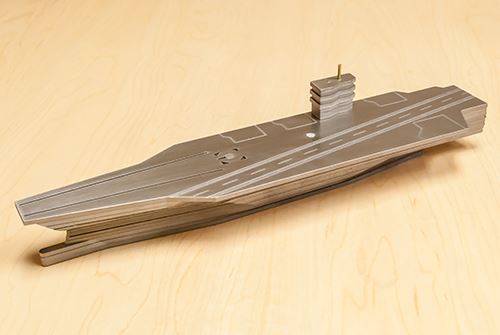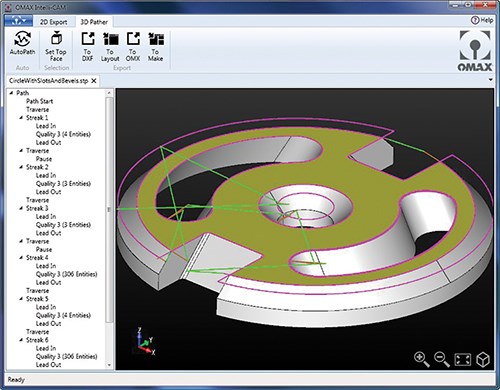CAM Software Enhances AWJ as an Additive Process
Intelli-CAM from Omax Corp is especially tailored for the needs of AWJ machine users. This CAM software provides features that support additive manufacturing applications.
Share




Many processes for additive manufacturing build up a workpiece in layers: curing resin layer by layer, sintering metal powder layer by layer or extruding a melted material in layer upon layer, for example. Building up a part by stacking slices cut by a five-axis abrasive waterjet (AWJ) cutting machine is also a possibility.
Advances in special software for programming AWJ machines enhance this option for additive manufacturing. CAD software is used to pre-slice a solid model into layers that can then be fed into CAM software to automatically apply the tool path along with bevel cuts, to help minimize what would otherwise be a jagged edge. The machine’s five-axis capability is used to bevel, angle or contour the edges. When the layers are stacked, the shaped edges produce an assembly with a smooth configuration that closely replicates the 3D model. The scale model of an aircraft carrier pictured on this page is an example of such an assembly.
The CAM software features needed for this additive manufacturing application are part of the enhancements included in Intelli-CAM from Omax Corp. (Kent, Washington). This programming software is especially tailored for the needs of AWJ machine users. Its capability to handle the unique demands of five-axis waterjet cutting are primarily responsible for the support of AWJ cutting as an additive process. Overall, however, this software is designed to speed programming for all applications in two-axis through five-axis waterjet cutting.
Intelli-CAM, which interfaces directly with the company’s Intelli-MAX software suite, generates 3D tool paths from solid 3D models as well as performs 3D-to-2D file conversions. Through its 3D Pather tool, the software generates multi-axis, machine-ready tool paths from complex 3D solid models. It automatically recognizes viable cutting surfaces from those 3D shapes, including variable bevels and tilted cones. This functionality eliminates the need to manually add 3D attributes to a 2D file, thus reducing production times.
The 3D solid is first converted into a series of slices using traditional CAD software, and each slice is sent to Intelli-CAM. Intelli-CAM then quickly assigns XY cutting, and tilt operations to each slice, which is then exported to the machine to be cut. According to developers, the end result can often be created faster than 3D printing or traditional milling, yielding a 3D model that can be manipulated and tested.
There are other inherent benefits of abrasive waterjet machining for this type of 3D additive manufacturing. The model can be cut from almost any material, so the finished model could interact in a magnetic environment, for example, or incorporate mixed materials on different slices to more closely replicate a finished part. The slicing concept is also highly customizable. The user can change details on one slice and try a new configuration without having to create an entirely new prototype. Additional information can be added to the prototype model with the Intelli-MAX scribe and etch features, which could be used to add artistic details, assembly refernce marks, or provide detailed callouts on the model itself.
This programming software operates as a stand-alone application or in tandem with third-party 3D CAD systems in a variety of neutral and native 3D file formats such as CATIA, SolidWorks, Solid Edge, Autodesk Inventor, Siemens NX, Pro/E, Creo, Step, IGES, VDA-FS, ACIS, Parasolid, 3D DXF and DWG.
Related Content
How to Mitigate Chatter to Boost Machining Rates
There are usually better solutions to chatter than just reducing the feed rate. Through vibration analysis, the chatter problem can be solved, enabling much higher metal removal rates, better quality and longer tool life.
Read MoreWhere Micro-Laser Machining Is the Focus
A company that was once a consulting firm has become a successful micro-laser machine shop producing complex parts and features that most traditional CNC shops cannot machine.
Read More5 Tips for Running a Profitable Aerospace Shop
Aerospace machining is a demanding and competitive sector of manufacturing, but this shop demonstrates five ways to find aerospace success.
Read MoreQuick-Change Tool Heads Reduce Setup on Swiss-Type Turning Centers
This new quick-change tooling system enables shops to get more production from their Swiss turning centers through reduced tool setup time and matches the performance of a solid tool.
Read MoreRead Next
5 Rules of Thumb for Buying CNC Machine Tools
Use these tips to carefully plan your machine tool purchases and to avoid regretting your decision later.
Read MoreSetting Up the Building Blocks for a Digital Factory
Woodward Inc. spent over a year developing an API to connect machines to its digital factory. Caron Engineering’s MiConnect has cut most of this process while also granting the shop greater access to machine information.
Read MoreRegistration Now Open for the Precision Machining Technology Show (PMTS) 2025
The precision machining industry’s premier event returns to Cleveland, OH, April 1-3.
Read More

































